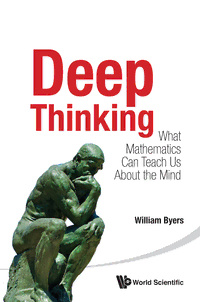Download Deep Thinking: What Mathematics Can Teach Us About The Mind PDF Free - Full Version
Download Deep Thinking: What Mathematics Can Teach Us About The Mind by William Byers in PDF format completely FREE. No registration required, no payment needed. Get instant access to this valuable resource on PDFdrive.to!
About Deep Thinking: What Mathematics Can Teach Us About The Mind
There is more than one way to think. Most people are familiar with the systematic, rule-based thinking that one finds in a mathematical proof or a computer program. But such thinking does not produce breakthroughs in mathematics and science nor is it the kind of thinking that results in significant learning. Deep thinking is a different and more basic way of using the mind. It results in the discontinuous “aha!” experience, which is the essence of creativity. It is at the heart of every paradigm shift or reframing of a problematic situation.The identification of deep thinking as the default state of the mind has the potential to reframe our current approach to technological change, education, and the nature of mathematics and science. For example, there is an unbridgeable gap between deep thinking and computer simulations of thinking. Many people suspect that such a gap exists, but find it difficult to make this intuition precise. This book identifies the way in which the authentic intelligence of deep thinking differs from the artificial intelligence of “big data” and “analytics”.Deep thinking is the essential ingredient in every significant learning experience, which leads to a new way to think about education. It is also essential to the construction of conceptual systems that are at the heart of mathematics and science, and of the technologies that shape the modern world. Deep thinking can be found whenever one conceptual system morphs into another.The sources of this study include the cognitive development of numbers in children, neuropsychology, the study of creativity, and the historical development of mathematics and science. The approach is unusual and original. It comes out of the author's lengthy experience as a mathematician, teacher, and writer of books about mathematics and science, such as How Mathematicians Think: Using Ambiguity, Contradiction, and Paradox to Create Mathematics and The Blind Spot: Science and the Crisis of Uncertainty.
Detailed Information
| Author: | William Byers |
|---|---|
| Publication Year: | 2015 |
| ISBN: | 9789814618052 |
| Pages: | 264 |
| Language: | English |
| File Size: | 4.87 |
| Format: | |
| Price: | FREE |
Safe & Secure Download - No registration required
Why Choose PDFdrive for Your Free Deep Thinking: What Mathematics Can Teach Us About The Mind Download?
- 100% Free: No hidden fees or subscriptions required for one book every day.
- No Registration: Immediate access is available without creating accounts for one book every day.
- Safe and Secure: Clean downloads without malware or viruses
- Multiple Formats: PDF, MOBI, Mpub,... optimized for all devices
- Educational Resource: Supporting knowledge sharing and learning
Frequently Asked Questions
Is it really free to download Deep Thinking: What Mathematics Can Teach Us About The Mind PDF?
Yes, on https://PDFdrive.to you can download Deep Thinking: What Mathematics Can Teach Us About The Mind by William Byers completely free. We don't require any payment, subscription, or registration to access this PDF file. For 3 books every day.
How can I read Deep Thinking: What Mathematics Can Teach Us About The Mind on my mobile device?
After downloading Deep Thinking: What Mathematics Can Teach Us About The Mind PDF, you can open it with any PDF reader app on your phone or tablet. We recommend using Adobe Acrobat Reader, Apple Books, or Google Play Books for the best reading experience.
Is this the full version of Deep Thinking: What Mathematics Can Teach Us About The Mind?
Yes, this is the complete PDF version of Deep Thinking: What Mathematics Can Teach Us About The Mind by William Byers. You will be able to read the entire content as in the printed version without missing any pages.
Is it legal to download Deep Thinking: What Mathematics Can Teach Us About The Mind PDF for free?
https://PDFdrive.to provides links to free educational resources available online. We do not store any files on our servers. Please be aware of copyright laws in your country before downloading.
The materials shared are intended for research, educational, and personal use in accordance with fair use principles.

